From Prague, we decided to head for Italy. We had a long journey ahead of us across the entire Austria and a third of Italy. We chose Lucca as our place of stay. It is located right near the tourist hotspot of Pisa, yet it offers a much quieter and more comfortable living environment.
An Overnight Stop in Trins
We traveled to Lucca by car. It would take us about 12 hours of non-stop drive to get to Lucca. Of course, even for us, it would be tiring to travel in a car for such a long time. And our boys would definitely take it even harder. So, in the middle of the way, we stopped for a night in Trins.

Trins is a small Austrian town located in the Province of Tyrol. It is a perfect place for those seeking to escape the bustling city life and spend some time surrounded by nature.

The beauty of Trins is captivating: nestled amidst lush forests, crystal clear rivers, and waterfalls cascading down from high mountains, this small town represents the essence of Sicilian nature.
Despite its tiny size, Trins also has its own small attractions. For example, there is a small 15th-century church in the very heart of town.

And for winter sports enthusiasts, Trins offers a small ski resort.

History of Lucca
Lucca is a very old city. According to some hypotheses, people founded the first settlement here before 180 BC. Back then, it was known as “luk”, which meant “surrounded by water”.
Later, when the settlement became a Roman colony, it turned into a real city, and its name was changed to Luca. The Romans rebuilt the city, constructing the amphitheater, the forum, and the fortress wall. In the downtown, they also laid out streets, running from north to south and from east to west. The streets divided the city into blocks – insulae – and intersected at the forum. These streets and the forum remain the most vibrant and bustling areas of Lucca today.

Throughout its history, Lucca remained a relatively prosperous city. From the 6th to 8th centuries, roads connected it to Rome, Pisa, Florence, and other major Italian cities. In the 11th century, the silk trade, continuing throughout the Middle Ages, greatly enriched Lucca.
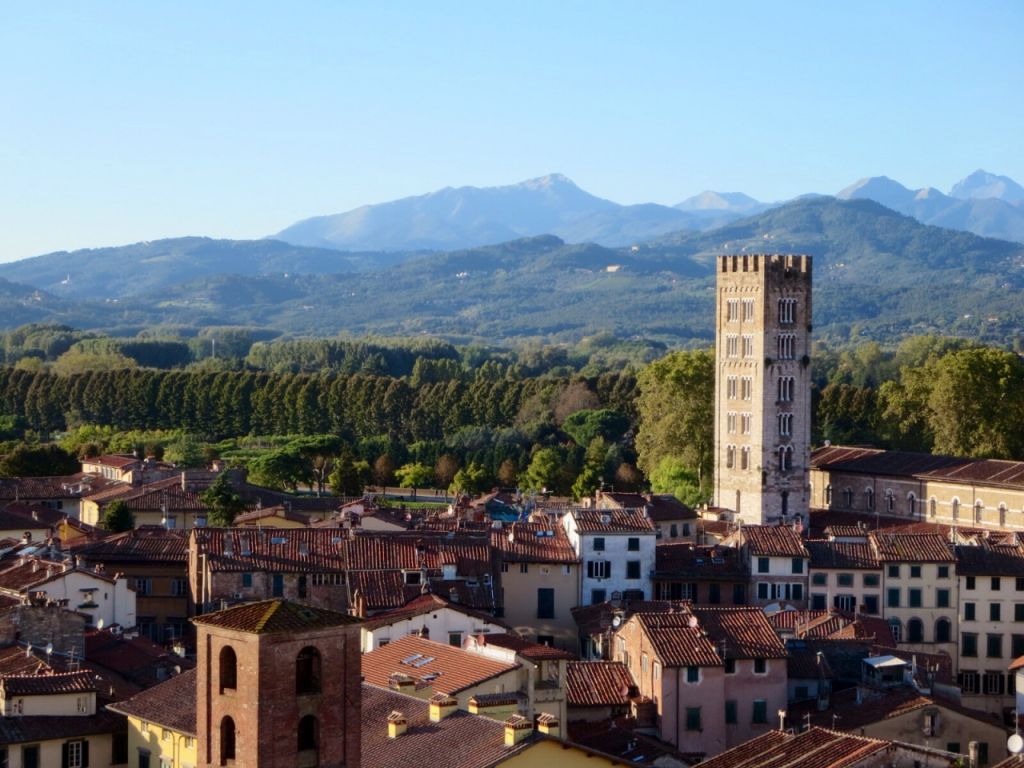
In the late 18th century, Lucca became part of Napoleon’s empire, and he appointed his sister Elisa as “Princess of Lucca”. This event is mentioned in Tolstoy’s “War and Peace”: “Well, Prince, so Genoa and Lucca are now just family estates of the Buonapartes.”
Finally, in the 19th century, Lucca joined the Grand Duchy of Tuscany and then, in 1861, became part of the Italian state.
The Walled City of Lucca
The defining feature of Lucca is the long wall. It encircles its historic downtown, also known as the old town, all the way around. The wall stretches for about 4.2 kilometers and was constructed between the 15th and 16th centuries as a fortification. Remarkably, it has remained largely intact throughout the centuries to this day.

The fortress wall boasts 11 bastions, 12 curtain walls, and 3 gates. From the latter half of the 19th century, it began to lose its defensive function. At that time, the wall’s top allowed residents to walk and admire the city view.
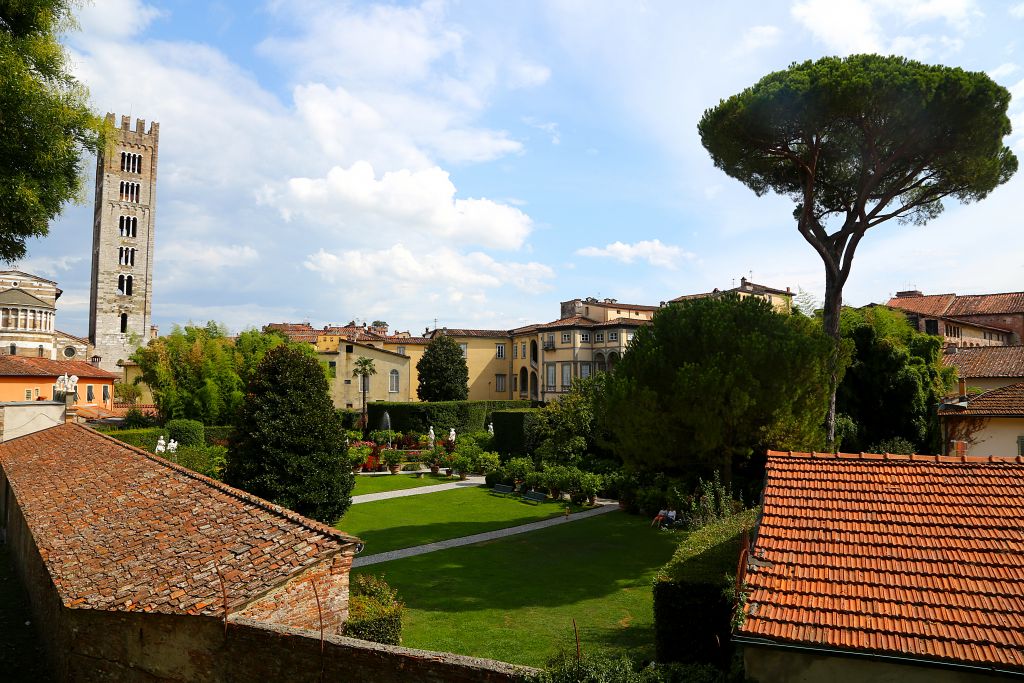
Today, visitors can access the wall’s top through multiple entrances, leading right to an alley lined with plane trees and other greenery. People enjoy picnics, dates, morning jogs, and simply relaxing on benches there.

We especially liked to spend time near the fortress wall with our kids. Beautiful old alleys and parks with playgrounds are located almost along its entire length. Sometimes, we spent hours there until the very night, and when our boys had played enough, we made our way home to put them to bed.
Where and How We Lived
We settled right in the downtown, enclosed by the fortress wall. However, we were unlucky with the house we rented. Due to its old age, we constantly faced issues with appliances, such as the heater and the washing machine malfunctioning.
Robert and Misha are having fun in our new house
Despite this drawback, we were still pleased with the location we had chosen. The old town is a highly picturesque area, replete with numerous playgrounds, towers, churches, museums, and fountains. Furthermore, restaurants offering traditional Tuscan cuisine were within easy walking distance.
Our kids are playing on one of the many playgrounds
Just down the road from our home, there was the Villa Bottini, a cultural monument formerly owned by Napoleon Bonaparte’s sister. The villa’s rectangular structure, surrounded by green gardens and gravel paths, contrasted sharply with the surrounding medieval architecture. Unfortunately, we could not get inside it since access to it was only permitted during exhibitions or cultural and gastronomic events.

Unforeseen City Regulations
On our first day in the city, we found out there were some regulations we had no idea about. Only residents who have a special permit are allowed to enter the old town by car. As we discovered later, this restriction is implemented in many Italian cities to preserve the historical heritage and prevent air pollution within the city walls.
Before arriving in Lucca, we knew nothing of this regulation, and, of course, we did not have any permit. In our car full of our belongings, we drove into the downtown and went straight to our accommodation, completely unaware that we were violating the regulations. The owner of the apartment, who met us at the house, was greatly surprised to see us arrive by car. He informed us about the special driving rules and that the fine for such a violation was around 200 euros!

Having learned this news, we no longer drove our car into the old town. We found a free parking area outside the walls and parked there. The distance from the apartment to the parking lot was walkable.
However, we later had to violate this regulation once again. When our stay in Lucca ended, we needed to somehow transport our belongings out of the old town. Of course, we obviously could not carry multiple items from the apartment to the car through the entire town, so we decided to be crafty. At night, having removed the license plates from our car, we drove into the old town, loaded all our belongings into the vehicle, and swiftly drove out of it at our own peril. Our car, brimming with luggage, remained outside the city walls until morning, and at daybreak, being a little anxious, we left the hospitable city of Lucca.

The Church of San Francesco
Just a few blocks from our accommodation, the was the magnificent Church of San Francesco. This magnificent building is one of the most important historical sites of Lucca. Built in the 13th century, it reflects the importance and influence of the Franciscan order at that time. The church took over a hundred years to complete, resulting in a structure that combines elements of Italian and French Gothic architecture.

The majestic face of the building with its multitude of elegant stained glass windows immediately charmed us. A lunette crowns the arch of the main entrance, while a large carved rose window stands out above it.

The walls inside the church are richly covered in paintings and frescoes telling the story of the life of Saint Francesco and his devotion to poverty and peace. On the north side, the Guinigi Chapel, a small oratory, adjoins the church.

Our visit to the church was made even more memorable by the discovery of a drum set that had been left inside after a concert. Our boys were particularly excited by it: as soon as they saw drums as tall as themselves, they were filled with wonder. They immediately started exploring the set and trying to play the drums, creating a cheerful atmosphere.
Lucca Cathedral
In the southern part of the old town, we often walked past a Roman Catholic church dedicated to Saint Martin of Tours. The construction of the church began in the 6th century, but it only acquired its current appearance in the 11th century.

The cathedral features a combination of Romanesque and Gothic architectural styles. A tower adjoins the cathedral on the right side, which is one of the many towers found in Lucca.

Today, the cathedral is renowned for its collection of artworks, which includes Madonna and Child with Saints by Domenico Ghirlandaio and the Holy Face of Lucca.
The Holy Face was created between 779 and 880 AD. The legend has it that it was brought to Lucca from Palestine in 782. It was created by Nicodemus, who helped Joseph of Arimathea to place Jesus Christ in the tomb after the crucifixion.

The cathedral also features a labyrinth carved into the stone at the entrance. This labyrinth represents the idea that believers should trust in God, who will guide them on the right path.

Napoleon Square
Napoleon Square was built by order of Elisa Baciocchi, sister of the famous Napoleon Bonaparte. Its construction required the demolition of several buildings, including residences, the post office, towers, and a church. However, after the demolition, the authorities discovered that the neighboring houses were not particularly nice. Therefore, they decided to cover them — a row of plane trees was planted around the entire perimeter of the square.

Elisa was going to install a statue of her brother in the center of the square. However, her plan failed since by that time, Maria Luisa of Spain came to power. Thus, a statue of Maria Luisa herself was installed in the square instead of the statue of Napoleon
We rarely saw the square empty – various events were constantly held there. In the summer, children played on the square, while parents sat on stone benches and watched them playing. In June, there is the annual Lucca Summer Festival. To celebrate this event, a large stage is erected in Napoleon Square. At Christmas, the city authorities install a Christmas tree and ice the rink there, and the remaining space is allocated for a market.
Amphitheater Square
The Amphitheater Square is undoubtedly one of the most alluring tourist destinations in Lucca, nestled in the center of the old town. We also enjoyed visiting this place, since it is home to a variety of restaurants that offer food for all tastes.

This location was once occupied by a monumental amphitheater, erected in the late 1st century AD. With a capacity of about 20,000 spectators, the amphitheater consisted of several tiers and sectors, each allocated to specific social classes. The total height of the structure was 13 meters!
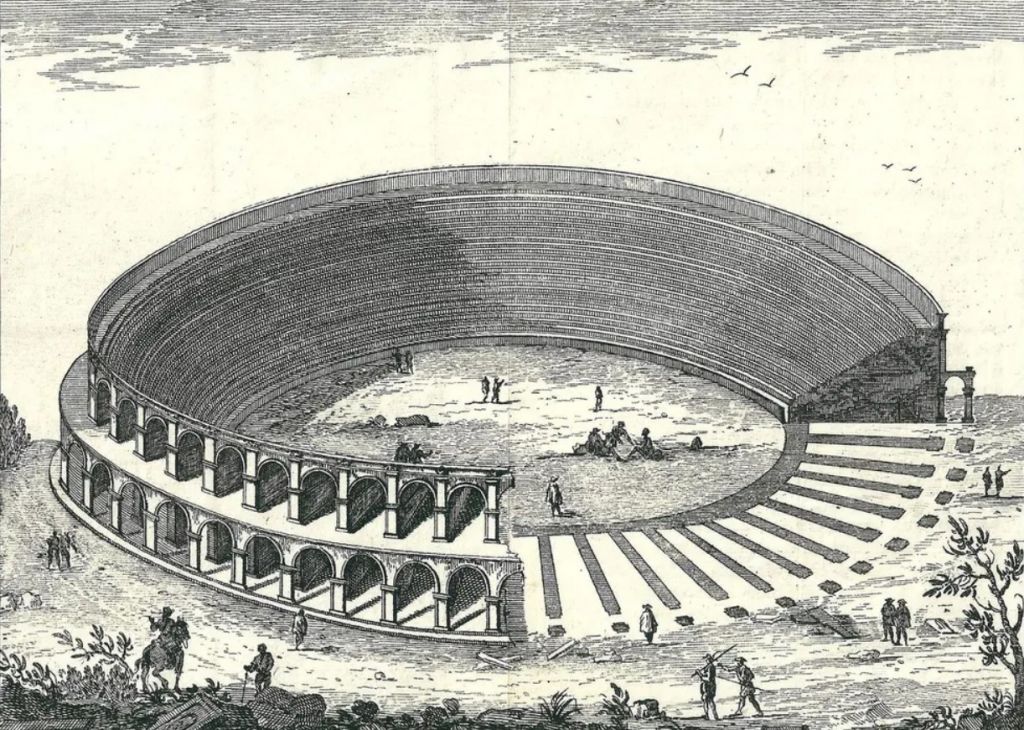
The amphitheater was originally designed with two entrances, through which gladiators emerged for their battles. However, only the eastern entrance has survived to this day.
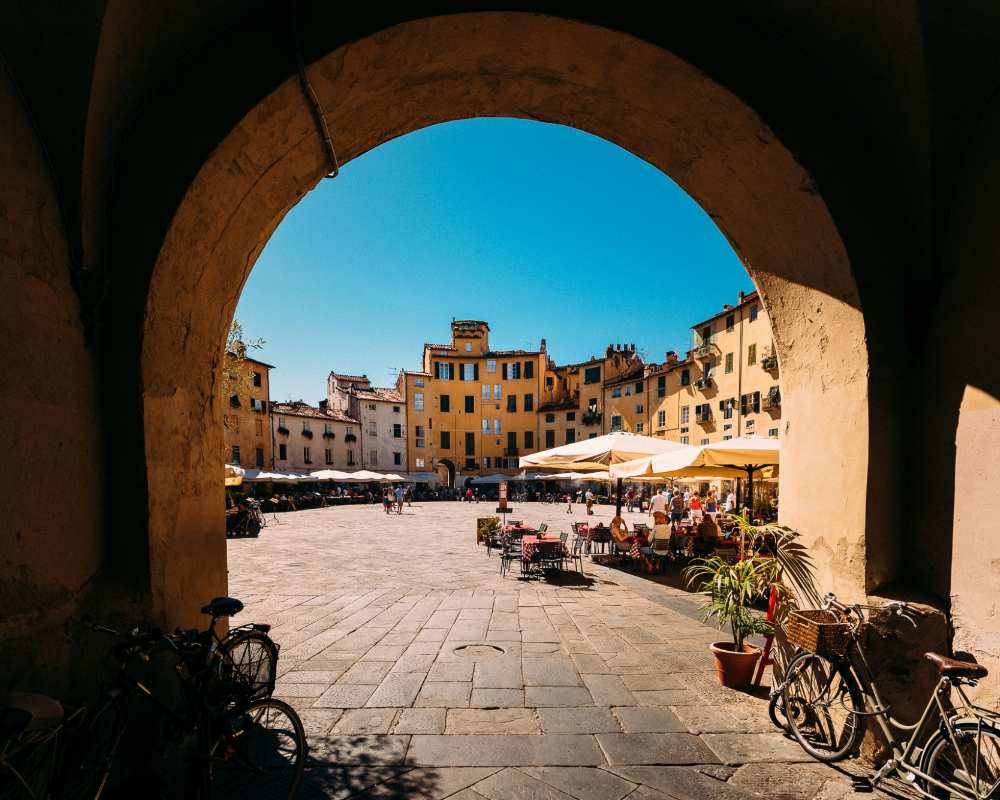
During the fall of the Roman Empire, the amphitheater began to deteriorate, as did many other Roman structures. Over time, the materials that made up the structure were gradually used to construct other buildings. For example, the nearby Basilica of San Frediano was built using materials from the decaying amphitheater.
In the 19th century, it was decided to build a city market in this area and demolish other structures. Only the houses surrounding the square were preserved.
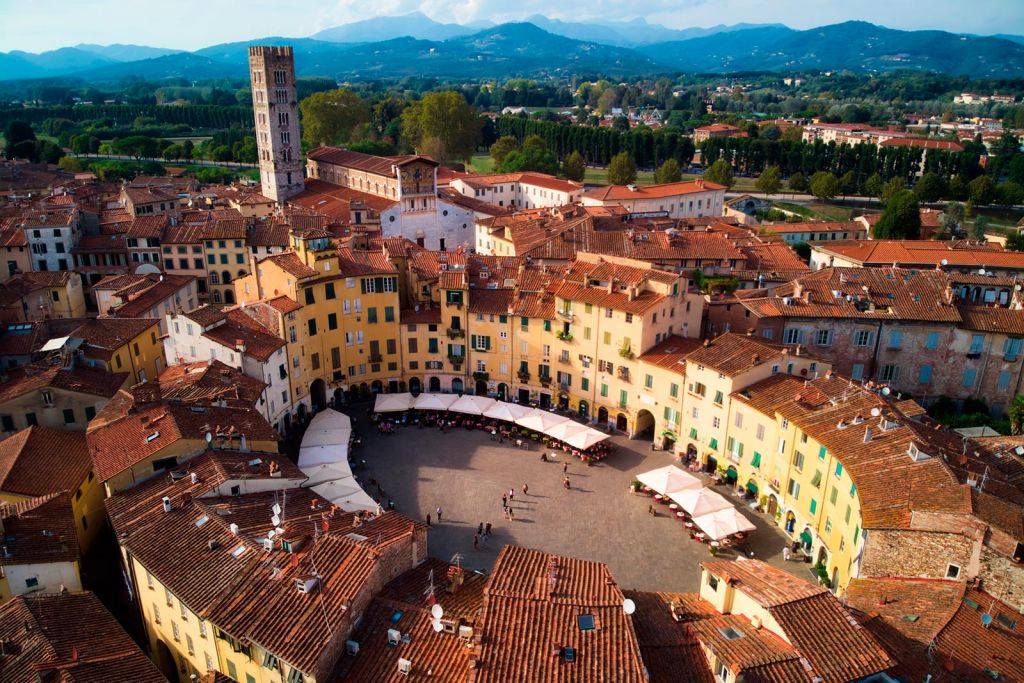
Basilica of San Frediano
A short distance from the Amphitheater Square, there is the Basilica of San Frediano.

This is an imposing Romanesque structure that boasts a tall tower, typical of Luccan buildings, at its rear part. The upper part of the basilica’s face features a mosaic depicting the Ascension of Christ.

The basilica bears the name of a revered Spanish martyr, whose relics are still preserved there. Additionally, a chapel situated on the basilica’s right side houses the relics of Saint Zita, the patroness of housemaids and servants. She was renowned for her compassion for the poor, patience, and humility.
We were equally fascinated by the church’s interior, decorated with exquisite white marble carvings.

The Virgin and the Child by Jacopo della Quercia
The bas-reliefs depict figures such as the Virgin Mary, Jesus, Saint Lawrence, Saint Jerome, and many others.

There is also a font inside the basilica decorated with various high reliefs depicting scenes from the life of Moses, including the crossing of the Red Sea and the Good Shepherd with prophets and apostles.
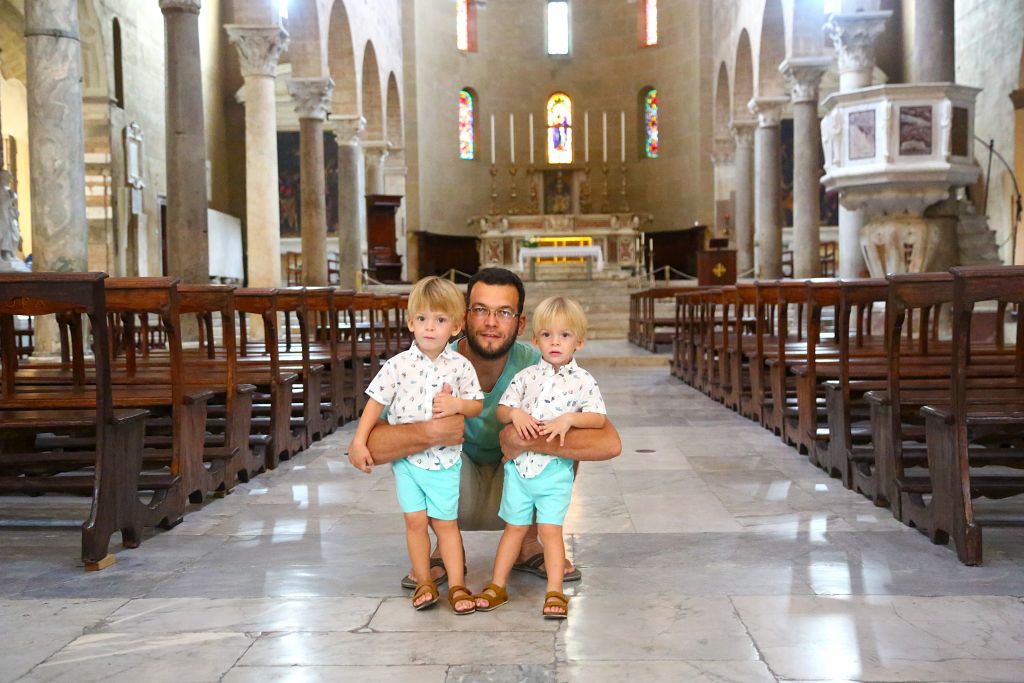
Church of San Michele in Foro
The Church of San Michele in Foro is a remarkably old structure, with its first mention dating back to the year 795. The church acquired its final external appearance only in the 19th century.
The church’s exterior immediately captured our attention with its classic Pisan style, characterized by numerous columns, inlays, and pilasters. The lower section of the building features several arcades, and the central arcade includes the main entrance.

The face of the church depicts numerous stone “portraits” of renowned figures, including Galileo Galilei, Napoleon, Christopher Columbus, and Dante Alighieri.

The church’s most distinctive feature is the four-meter statue of Saint Michael the Archangel, situated at its very top. The church is named after him, and according to legend, he wears a ring with a diamond on one of his fingers. People say that the ring can be seen sparkling at night.

Despite its luxurious appearance, the interior of the building is more restrained. It is filled with many artworks, including the Madonna with Child, a terracotta sculptural relief, by Andrea della Robbia.

Torre delle Ore
Walking just a block east of the church, we saw the Torre delle Ore, a tall clock tower that rises above the surrounding buildings. Today, it is the tallest of 130 towers in the city, reaching a height of 50 meters.
The Torre delle Ore was constructed in the 13th century, and in the 14th century, the city authorities decided to install a “good clock, sufficiently suitable and well-distinguishing time by hours” on it. Remarkably, the clock has never stopped working since they were first installed on the tower.

The building is associated with a curious legend about a woman named Lucida Mansi. The girl was extraordinarily beautiful but was also known for her cruel nature: she killed her husband and several lovers. Once, Lucida made a deal with the devil to preserve her youth. However, at the end of the contract, not willing to grow old, the girl climbed to the top of the tower and tried to keep the bell from ringing. That was how she wanted to stop time. But she failed: a carriage from hell arrived right at the tower and carried Lucida away to a lake near the city to get rid of the girl. To this day, it is said that people can see her face in the waters of the lake.
Guinigi Tower
The Guinigi Tower is slightly shorter than the clock tower, with a height of 45 meters. Being built around the same time, it belonged to the Guinigi family, successful merchants and bankers who used their success to gain political recognition. That was when they decided to construct this famous tower.
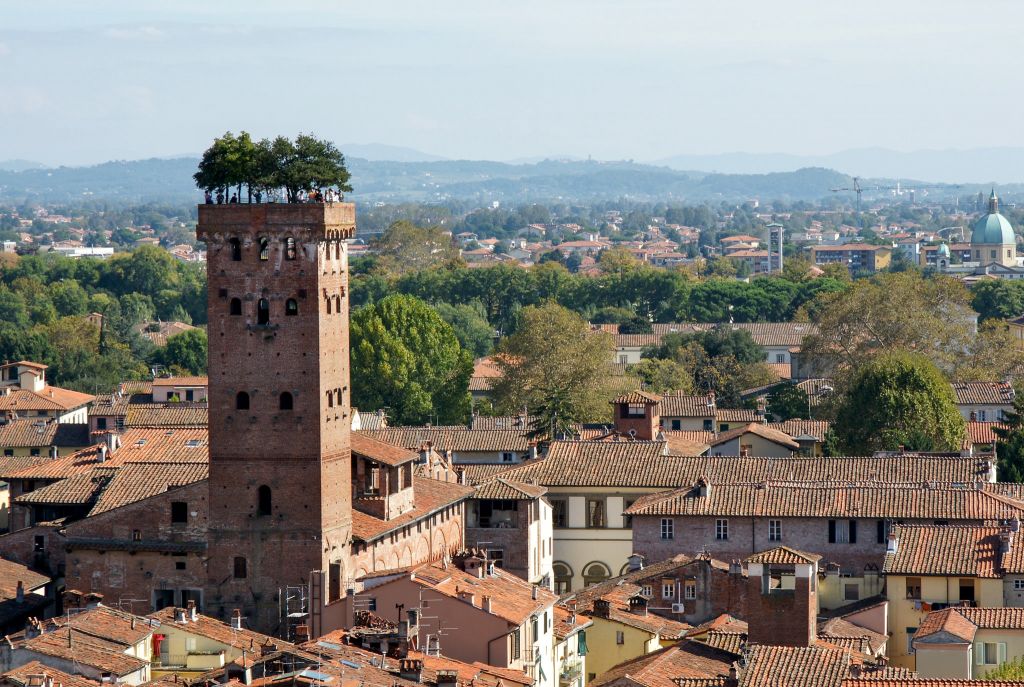
The tower is built of stone and brick and features a Romanesque-Gothic architectural style. The structure’s exterior is lightened by windows and decorated with stone tablets, coats of arms, and cornices. A unique feature of the Guinigi Tower is the small oak grove on its roof. Visitors can enjoy panoramic views of the city, the surrounding forests, hills, and fields from the rooftop, while the shade of the oak trees can cover them from the scorching sun.

Palazzo Pfanner
In the northern part of the old town, we found the Palazzo Pfanner, a captivating palace that left us mesmerized.

It is surrounded by a large garden, where lemon trees, bamboo, yew trees, and pines grow in abundance. The flower beds are adorned with camellias, magnolias, peonies, and other flowers. There are 18 statues along the alleys depicting the Olympian gods and the four seasons.
The palace itself is no less alluring. Its grand sandstone staircase leads directly to the spacious main hall. There, people can admire frescoes created in the quadrature style. The quadrature style was highly popular in Lucca during the second half of the 17th century. It is characterized by the use of artistic techniques to create the illusion of an expanded space.

Today, the palace hosts various events, such as exhibitions of medical instruments and movie screenings. It is also open to visitors who want to enjoy its artworks, including paintings, frescoes, and sculptures.
Aqueduct of Nottolini
The impressive structures of Lucca are located not only in the old town but also beyond its boundaries. One such example is the Aqueduct of Nottolini, which we frequently passed by on our way to the beach. This is brick-built bridgework that spans a distance of 3 kilometers and boasts over 400 arches!
Built in the 19th century, the structure was constructed to transport water to Lucca from the mountains on the south side.

Festivals of the City
Lucca is renowned for its festivals. Every year it hosts a summer festival featuring world rock stars such as Sting, Eric Clapton, The Rolling Stones, Bob Dylan, and others. Additionally, people can also visit the festivals dedicated to the composer Giacomo Puccini, jazz music, cinema, and more.

Restaurants
There are a lot of restaurants in Lucca, so we always had plenty to choose from. As usual, we tried to select restaurants by reviews and visited the most interesting ones. The Amphitheater Square is particularly rich with restaurants, situated along its perimeter in the surrounding buildings.

However, the quality of service and overall standards in these establishments are not the same as in restaurants outside the walls. Many of them cater primarily to tourists and are intended for one-time visits. Therefore, we did not feel like coming back there again and again after our first visit. To discover the real culinary gems, you need to go off the well-worn tourist trails and explore the ones lying beyond these places.
Tourists
While there are a lot of tourists in Lucca, particularly in the old town, it remains relatively uncrowded compared to nearby cities like Pisa. And this was great, as we could wander the narrow cobbled streets and admire the sights without the throngs of people typically surrounding popular landmarks.

The city also boasts a multitude of stores selling local souvenirs, where you can find postcards, magnets, and other keepsakes to memorize your visit.







Leave A Comment